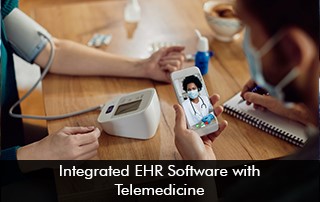The global pandemic changed the way how the healthcare landscape is navigated. It made Telemedicine EMR Software solutions take the center stage in providing remote care to patients. When COVID-19 was at its highest, telemedicine sessions accounted for 80% of areas where the situation got worse. The robust platform enabled patients to get access to their normal care without having to visit the doctor’s office lowering the spread of the virus. A study from November 2021 revealed that most post-discharge visits were conducted using telehealth.
There are numerous benefits of telemedicine software which has provided effective and safe care delivery options to patients of all age groups, however, there are certain challenges when it comes to telehealth and EMR Software systems. For example, is it difficult to take notes during a telemedicine session? Let’s delve deeper into the dynamics of navigating the relationship between Electronic Health Records (EHR) Software documentation and telemedicine.
The Existing Challenges
Before the pandemic hit the world there were many barricades to telemedicine implementation faced by hospitals and physicians such as coverage, payments, and, privacy requirements. However, things changed for the better making telemedicine operations smoothly. it is now a fundamental tool used by healthcare providers in the US.
An EMR system that is not built for telehealth can make record-keeping less effective because providers need to switch between various solutions which may add to physician burnout. Clinicians need to multi-task, such as taking manual notes, dictating, and operating on separate screens.
The sudden change due to the pandemic caused many providers to struggle to find proactive solutions in how care was provided to their patients. Managing different technological solutions made the patient care process cumbersome as systems did not work well together increasing the doctor’s time in note-taking and record-keeping. As a physician, the focus is taking care of patients and not struggling with clinical workflows.
These trials can only be solved with integrated EHR Software solutions which can decrease the time spent consolidating and managing health records. Streamlining workflows can help reduce physician stress and enhance productivity levels which can lead to better patient care.
The Advantages of Integrated EHR Software System
Taking patient notes is critical during a telemedicine session and a well-integrated solution will integrate these notes directly into the same software as the calls and patient records are kept together.
Transcription technologies such as voice recognition software aid physicians to dictate notes and also editing and organize them with much ease. A top-ranked Telehealth solution with powerful features reduces the doctor’s time typing, improving efficiency levels.
An integrated EMR Software also allows the clinician to easily edit patient charts during a telemedicine session without having to switch between devices or systems. All the information is on the same screen which makes it possible for the provider to focus on the patient which can lead to improved diagnosis and treatment path. This also optimizes the clinical workflow.
Final Takeaway
An integrated Electronic Health Records software solution makes telemedicine sessions more proactive as workflows are streamlined aiding the provider to have all the data on a single screen during the virtual session. The struggle of switching and clicking is eliminated. The provider has all updated information in one place which can be referred to, making telehealth sessions even more effective.







